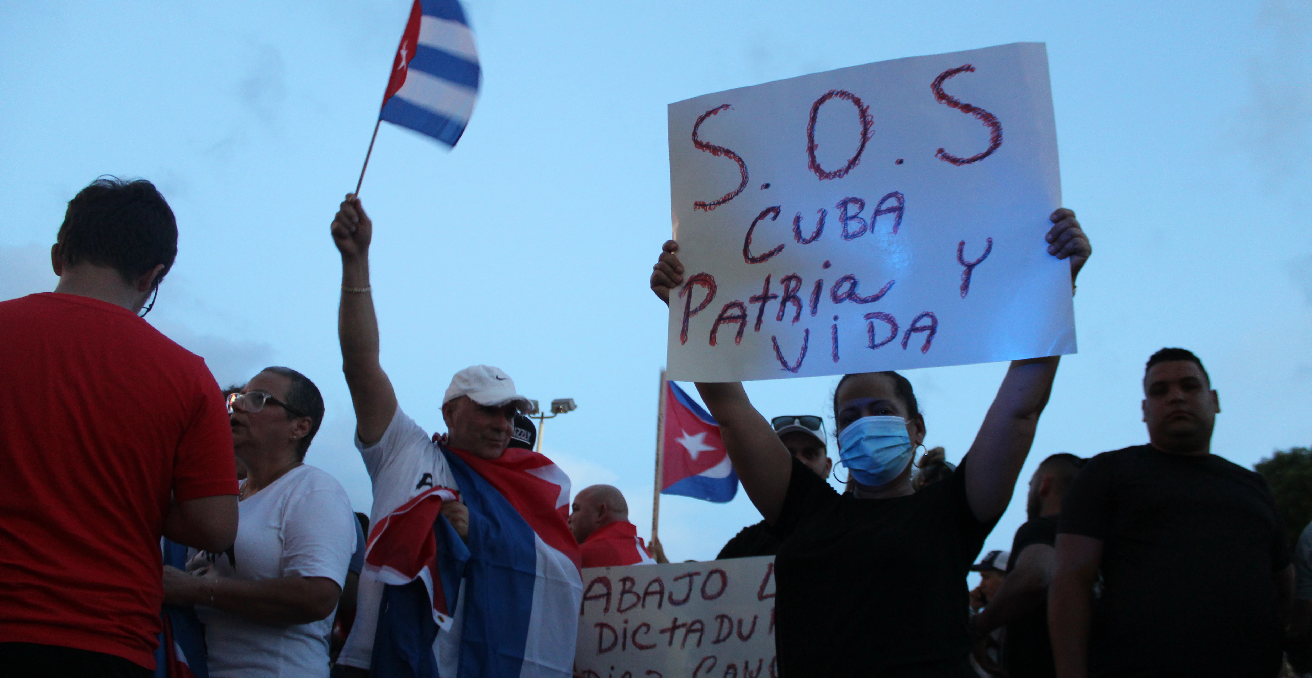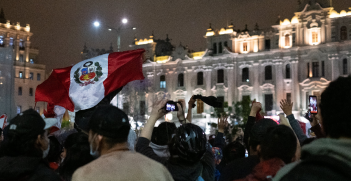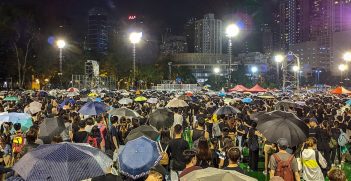SOS Cuba: Protests on the Island

On Sunday, 11 July 2021 (J11), thousands of Cubans took to the streets to voice their discontent with the Cuban government. This was the most popular manifestation of anti-government sentiment since the early 1960s.
Many demonstrators loudly chanted libertad (freedom), “down with the dictatorship,” and Patria y vida (Fatherland and Life), the title of a critical rap song by Yotuel Romero, Gente de Zona, and other Cuban singers, which went viral in February. They also demanded the resignation of current president Miguel Díaz-Canel, calling him insulting names. The protests started in the town of San Antonio de los Baños, near the capital of Havana, and quickly spread throughout the island. Many young Black Cubans, both men and women, participated in these events.
Several interrelated forces triggered the protests. First was the coronavirus pandemic, which has intensified in Cuba in the last few weeks and has led to a healthcare crisis, particularly in the province of Matanzas. After limiting the outbreak of coronavirus cases during most of 2020, Cuba now has the highest per capita rate of COVID–19 infections in Latin America and the Caribbean.
Secondly, the Cuban economy is experiencing a profound recession, registering an 11 percent decline in 2020, per official figures. The closing of the island’s borders, which in turn caused a collapse of the tourist industry, the mainstay of the Cuban economy, has had a high financial cost, including a major loss in foreign currency.
The third basic issue was the tightening of the US embargo under Donald Trump’s administration (2017–21), which made daily life more miserable for ordinary Cuban citizens. The loss of massive subsidies from Venezuela, especially oil imports, has created additional strains on the Cuban economy, notably chronic power outages.
What critics call the island’s “internal embargo”—for example, the government’s restrictive policies toward self-employment, especially in professional services—makes it difficult for the private sector of the economy to prosper. Finally, Cuba has shown signs of growing political unrest, including protests against the limitation of freedom of expression and other civil liberties. was an unprecedented public manifestation by artists and writers that took place on November 27, 2020, in front of Havana’s Ministry of Culture. In short, Cuba is currently facing a “perfect storm” of economic, political, and health challenges.
Social media played a key role in the J11 protests, communicating information about the demonstrations arising throughout the island. Videos, photographs, and text messages, many using the hashtag #SOSCuba, were disseminated through digital platforms such as Facebook, Twitter, WhatsApp, Instagram, and Telegram. Widespread access to such platforms allowed Cubans to share their grievances among themselves and project them abroad. While some journalistic reports have identified external efforts to “agitate” the Cuban population through social media campaigns, most of the protests seemed spontaneous and peaceful, though a few isolated instances of violence did occur. The US government has denied any role in promoting the J11 uprisings.
The protests were not called by a single opposition leader or organization, although the Cuban regime quickly detained some of the most visible dissidents. This is the first time in recent memory that economic and health complaints—such as the scarcity of food, medicine, fuel, and other basic necessities—were translated into explicit political demands for reform and even regime change.
The only experience comparable to the J11 protests, after the Cuban Revolution of 1959, was the 5 August 1994 Maleconazo (from the Malecón, the famous Havana waterfront). The Maleconazo uprising took place amidst the worst economic crisis in Cuba since the Great Depression, which followed the disappearance of the Soviet Union in 1991, then the island’s main trade partner and political ally. Hundreds of protestors marched through Centro Habana, vandalizing stores and hotels, but the police quickly dispersed them, and Fidel Castro, then Cuba’s president, appeared on the scene to appease the crowds.
On 12 August 1994, Castro announced that anyone wishing to leave Cuba could do so. This decision unleashed the balsero crisis, during which the U.S. Coast Guard detained nearly 31,000 Cuban rafters in two months. They were eventually admitted into the United States. The Cubans’ strategy of resorting to emigration as a “safety valve” seems unviable under current conditions.
In response to the J11 protests, the Cuban government quickly blocked access to the Internet on the island. President Miguel Díaz-Canel held a press conference in which he called on his sympathisers to defend the Revolution in the streets, which was widely interpreted as an invitation to violence and civil war. The government mobilised its special forces brigade (the “Black Berets”), police officers, and plain-clothes agents to crush the manifestations. Hundreds of dissident leaders and demonstrators were arrested, imprisoned, and subject to summary judgments.
The US government supported the right to peaceful demonstration, condemned the violent repression of the protests, and sanctioned Cuban officials and organisations accused of orchestrating this repression, such as the minister of defense and the heads of the police force. The Biden administration is considering ways to expand Internet access in Cuba, facilitate Cuban-American remittances without benefitting the Cuban government, and reopen the consular section of the US Embassy in Havana so regular migration flows can resume. The Biden administration seems to be treading a fine line between President Barack Obama’s engagement with Cuba and President Trump’s isolationist measures.
The Cuban-American community has staged massive street demonstrations in Miami, Washington, DC, New York, and other cities to express solidarity with the J11 protests. Some exiles have celebrated what they hope is “the beginning of the end” of the Cuban socialist regime, while others remain skeptical of its imminent demise. Media reports suggest widespread support among Cuban Americans for a US military intervention in Cuba, but ranking Cuban-American senator Bob Menéndez has rejected that option outright. Leaders of the Cuban-American community are split between those supporting humanitarian aid and easing restrictions on remittances and travel to the island, and those advocating harsher economic and political sanctions on Cuba.
Violent confrontations between supporters and critics of the Cuban government have now mostly subsided, largely due to a massive display of military and paramilitary force throughout the island. The state-owned monopoly telecommunications provider, ETECSA, has restored most of the population’s access to the Internet, although intermittent blackouts have been reported. The Cuban government has timidly reassessed some of its policies, such as authorising the duty-free importation of food and medicine, and legalising micro, small, and medium enterprises.
In the long run, however, no government, whether democratic or authoritarian, can afford to ignore such a clear and vocal expression of pervasive disaffection as the J11 protests. It seems urgent to establish formal mechanisms to reconcile opposing viewpoints and promote peaceful negotiation between pro-government and anti-government groups in Cuba. The pace of economic and political reform will have to accelerate to improve the daily lives of the Cuban people. This would include increasing “normalization” of ties between Cuban families on the island and in the diaspora. One conclusion evident at this point in Cuban history is a pressing demand for change among the population, rather than continuity, as the official discourse insists in Cuba. What kind of change is still very much open to debate on the island and abroad.
Jorge Duany is Director of the Cuban Research Institute and Professor of Anthropology at Florida International University in Miami. He holds a Ph.D. in Latin American Studies, with a concentration in anthropology, from the University of California, Berkeley. He has published extensively on migration, ethnicity, race, nationalism, and transnationalism in Cuba, the Caribbean, and the United States. He is the author, coauthor, editor, or coeditor of 22 books, including Obra selecta (2021), Picturing Cuba: Art, Culture, and Identity on the Island and in the Diaspora (2019), and Puerto Rico: What Everyone Needs to Know (2017).
This article is published under a Creative Commons License and may be republished with attribution.





